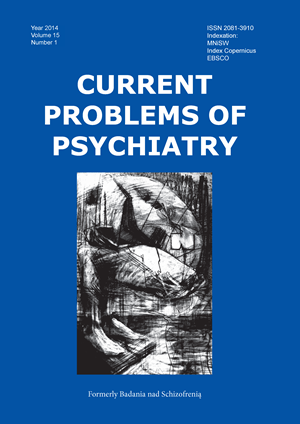Evidence for the similar biochemical background for psychiatric disorders and psychoactive substances addiction
Keywords:
addiction, psychiatric disorders, neuroimaging techniquesAbstract
Nowadays, the effects of psychoactive substances dependence are becoming more severe and acute on the social level, so this topic of research appears in the orbit of interest to many subdisciplines, such as psychiatry, neuropsychology, neurosciences and biochemistry. The authors conducted a literature review devoted to psychiatric disorder and addiction to alcohol and other psychoactive substances in order to present evidence for the similar biochemical and neurophysiologic background for both of the mentioned above disorders. In this paper there are presented data of animal models, neuroimaging techniques and neuropsychological tests. Moreover, the authors of this paper try to identify the possible link between personality traits (e.g. impulsivity or novelty seeking) or inborn properties of the central nervous system and the development of addiction that can gradually lead to irreversible brain changes. The authors also address the phenomena of self-medication among schizophrenic patients using regularly tobacco. In the article there is also discussed the potential application of psychostimulants in the treatment of disorders such as Attention Deficit Hyperactivity Disorder (ADHD) or narcolepsy.
References
1. Koob, G., Le Moal, M. Drug abuse: Hedonic homeostatic dysregulation. Science, 1997; 278 (5335), 52.
2. Gazzaniga, M., Ivry, R., Mangun, G. Cognitive neuroscience. The biology of mind. New York; W.W.Norton and Company: 2002.
3. Nestler, E., Hyman, S., Malenka, R. Molecular Neuropharmacoogy. A Foundation for Clinical Neurosciences. New York; The McGraw – Hill Company: 2009.
4. Katona, I., Rancz, E., Acsady, L., Ledent, C., Mackie, K., Hajos, N. Distribution of CB1 cannabinoid receptors in the amygdala and their role in the control of GABAergic transmission. The Journal Of Neuroscience: The Official Journal Of The Society For Neuroscience, 2001; 21(23).
5. Rais, M., Cahn, W., Van Haren, N., Schnack, H., Caspers, E., Hulshoff, H. Excessive brain volume loss over time in cannabis-using first-episode schizophrenia patients. The American Journal of Psychiatry, 2008; 165(4): 490-496.
6. Andréasson, S., Allebeck, P., Engström, A., Rydberg, U. Cannabis and schizophrenia. A longitudinal study of Swedish conscripts. Lancet, 1987,2(8574): 1483-1486.
7. Fernandez-Espejo, E., Viveros, M., Núñez, L., Ellenbroek, B., Rodriguez de Fonseca, F. Role of cannabis and endocannabinoids in the genesis of schizophrenia. Psychopharmacology, 2009; 206(4): 531-549.
8. Lyon, E. A review of the effects of nicotine on schizophrenia and antipsychotic medications. Psychiatric Services, 1999; 50(10): 1346-1350.
9. Velasco, J., Eells, T., Anderson, R., Head, M. A two-year follow-up on the effects of a smoking ban in an inpatient psychiatric service. Psychiatric Services, 1996; 47(8): 869-871.
10. Valdez, G., Roberts, A., Chan, K., Davis, H., Brennan, M., Zorrilla, E. Increased ethanol self-administration and anxiety-like behavior during acute ethanol withdrawal and protracted abstinence: Regulation by corticotropin-releasing factor. Alcoholism: Clinical and Experimental Research, 2002; 26(10): 1494-1501.
11. Sullivan, E., Pfefferbaum, A. Neuroimaging of the Wernicke–Korsakoff Syndrome. Alcohol and Alcoholism, 2009; 44(2): 155-165.
12. Goldstein, R., Volkow, N. Drug Addiction and Its Underlying Neurobiological Basis: Neuroimaging Evidence for the Involvement of the Frontal Cortex. American Journal of Psychiatry, 2002; 159(10): 1642.
13. Lubman, D., Yücel, M., Pantelis, C. Addiction, a condition of compulsive behaviour? Neuroimaging and neuropsychological evidence of inhibitory dysregulation. Addiction, 2004; 99(12): 1491-1502.
14. Volkow, N., Fowler, J., Wang, G. The addicted human brain : insights from imaging studies. Journal of Clinical Investigation, 2003; 111(10): 1444-1451.
15. Shamamatus-Sabah, S., & Najam, N. Comparison of memory deficits among chronic schizophrenics, drug addicts, and normals. Pakistan Journal of Psychological Research, 2007; 22(3-4): 91-106.
16. Nnadi, C., Mimiko, O., McCurtis, H., Cadet, J. Neuropsychiatric effects of cocaine use disorders. Journal Of The National Medical Association, 2005; 97(11): 1504-1515.
17. Rapeli, P., Kivisaari, R., Autti, T., Kähkönen, S., Puuskari, V., Jokela, O. Cognitive function during early abstinence from opioid dependence: a comparison to age, gender, and verbal intelligence matched controls. BMC Psychiatry, 2006; 6(1): 9.
18. Pelchat, M. Of human bondage: Food craving, obsession, compulsion, and addiction. Physiology and Behaviour, 2002; 76(3): 347-352.
19. Schilman, E., Uylings, H., Graaf, Y., Joel, D., Groenewegen, H. The orbital cortex in rats topographically projects to central parts of the caudate–putamen complex. Neuroscience Letters, 2008; 432(1): 40-45.
20. Belin, D., Everitt, B. Cocaine Seeking Habits Depend upon Dopamine-Dependent Serial Connectivity Linking the Ventral with the Dorsal Striatum. Neuron, 2008; 57(3): 432-441.
21. Goldstein, R., Volkow, N. Drug Addiction and Its Underlying Neurobiological Basis: Neuroimaging Evidence for the Involvement of the Frontal Cortex. American Journal of Psychiatry, 2002; 159(10): 1642.
22. Tallis F. Obsessive – Compulsive Disorder. A Cognitive and Neuropsychological Perspective. Chichester; Wile: 1995.
23. Belin, D., Robbins, T., Everitt, B., Mar, A., Dalley, J. High Impulsivity Predicts the Switch to Compulsive Cocaine-Taking. Science, 2008; 320(5881): 1352-1355.
24. Poulos, C., Le, A., Parker, J. Impulsivity predicts individual susceptibility to high levels of alcohol self-administration. Behavioural Pharmacology, 1995; 6(8): 810-814.
25. Nigg, J., Wong, M., Martel, M., Jester, J., Puttler, L., Glass, J. Poor Response Inhibition as a Predictor of Problem Drinking and Illicit Drug Use in Adolescents at Risk for Alcoholism and Other Substance Use Disorders. Journal of the American Academy of Child and Adolescent Psychiatry,2006; 45(4): 468-475.
26. Sagvolden, T., Tong, X. l-Amphetamine improves poor sustained attention while d-amphetamine reduces overactivity and impulsiveness as well as improves sustained attention in an animal model of Attention-Deficit/Hyperactivity Disorder (ADHD). Behavioral and Brain Functions, 2008; 41: 12.
27. Piazza, P., Deminière, J., le Moal, M., Simon, H. Factors that predict individual vulnerability to amphetamine self-administration. Science, 1989; 245(4925): 1511-1513.


